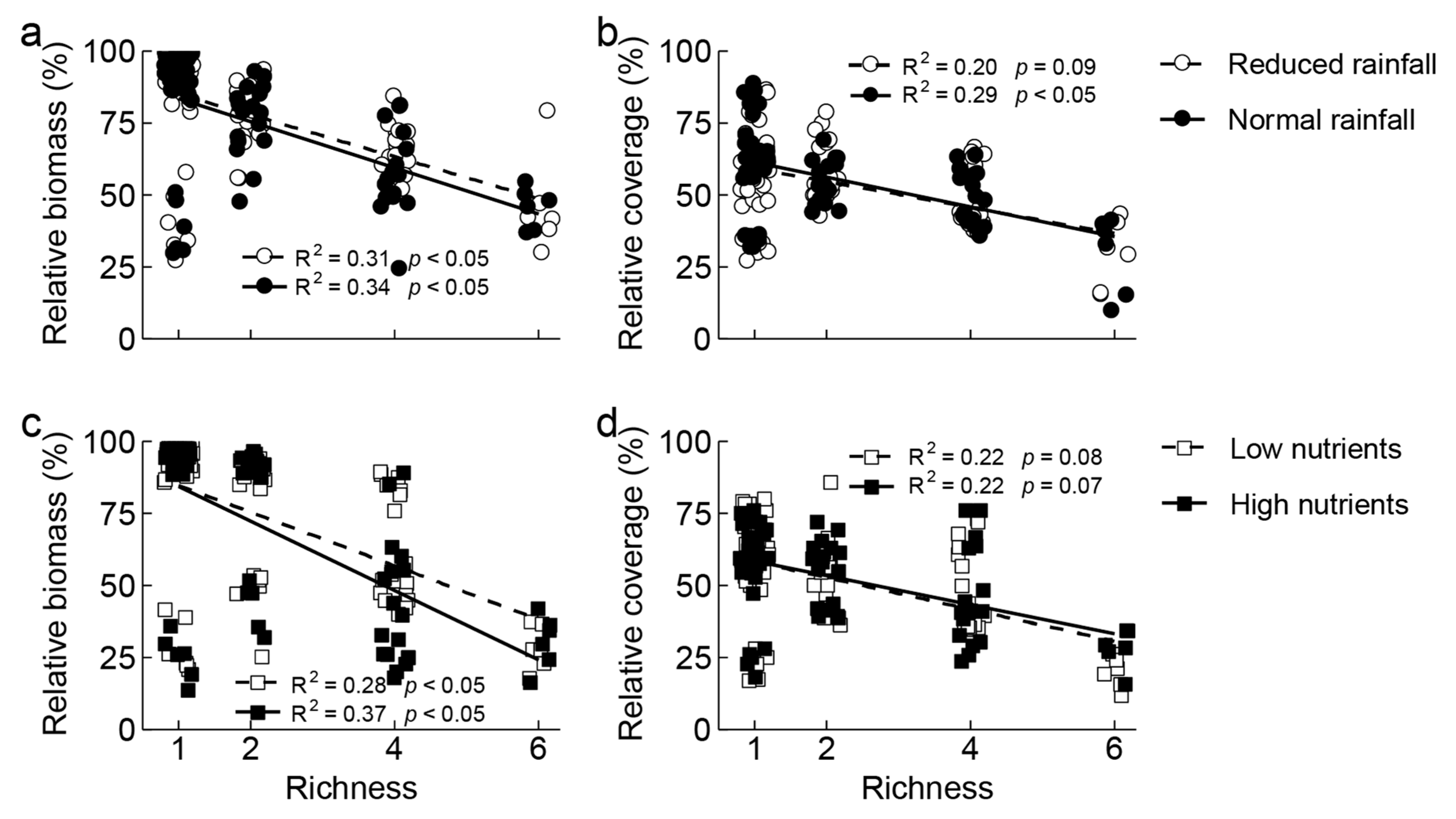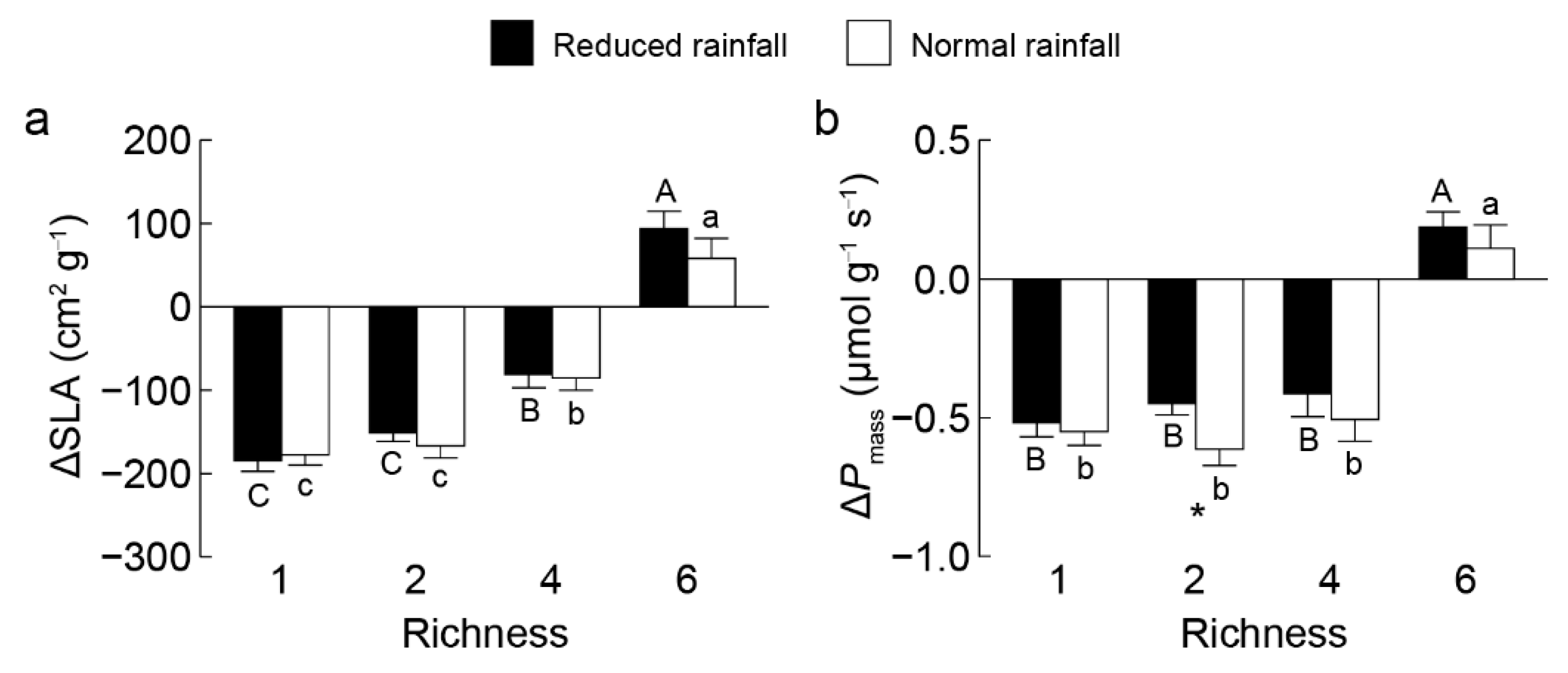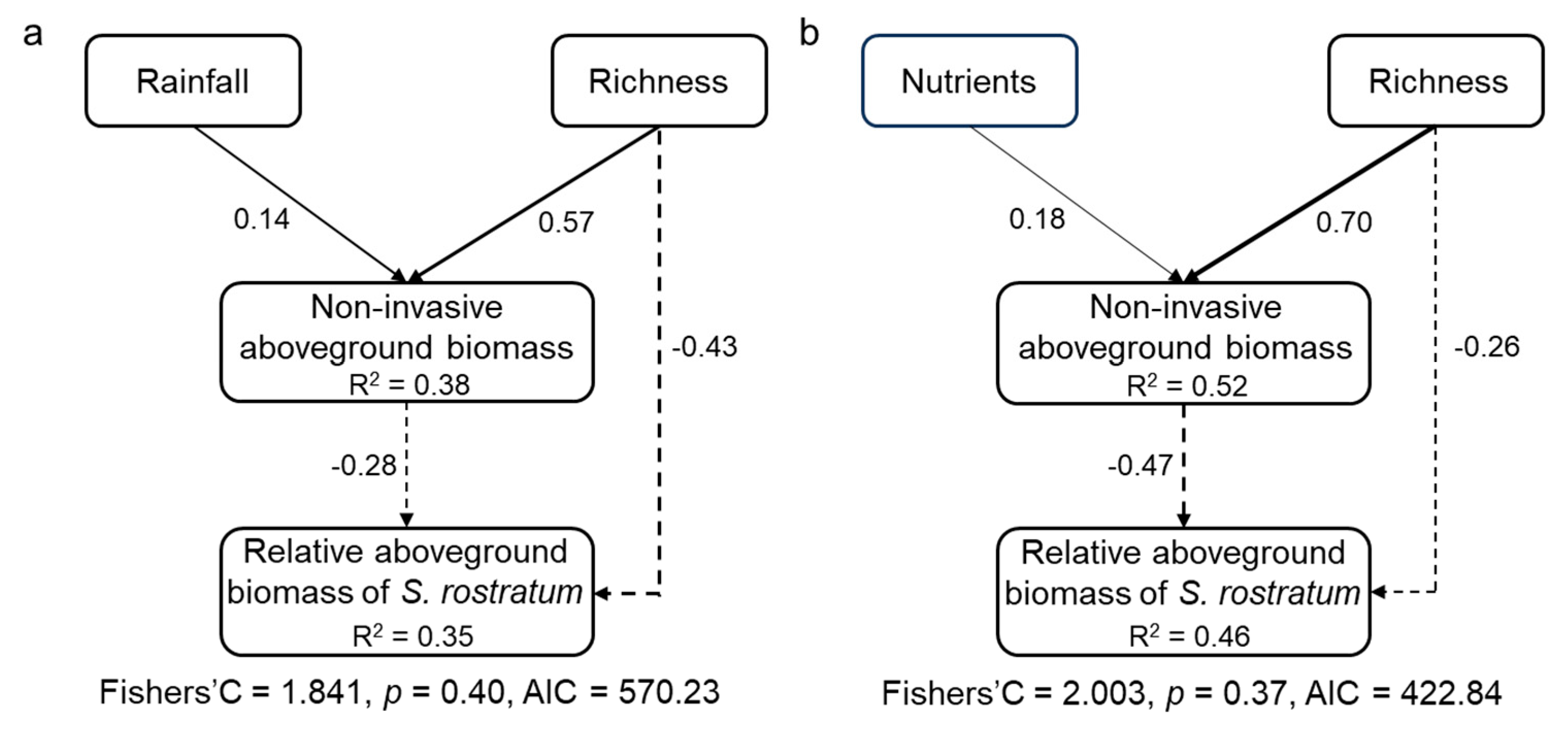The Relative Growth of Invasive Solanum rostratum Dunal Decreases with Increasing Competitive Species Richness Regardless of Resource Conditions
Abstract
1. Introduction
2. Results
2.1. Effects of Non-Invasive Species Richness, Water, and Nutrients Treatments on S. rostratum
2.2. Effects of Non-Invasive Species Richness on CWM Traits and Its Differences Between Non-Invasive and Invasive Species
2.3. Direct and Indirect Effects of Species Richness and Soil Resources on S. rostratum
3. Discussion
4. Materials and Methods
4.1. Study Sites and Non-Invasive Species
4.2. Experimental Design
4.3. Parameter Measurements
4.4. Statistical Analyses
5. Conclusions
Supplementary Materials
Author Contributions
Funding
Data Availability Statement
Acknowledgments
Conflicts of Interest
References
- Vilà, M.; Espinar, J.L.; Hejda, M.; Hulme, P.E.; Jarošík, V.; Maron, J.L. Ecological impacts of invasive alien plants: A meta-analysis of their effects on species, communities and ecosystems. Ecol. Lett. 2011, 14, 702–708. [Google Scholar] [CrossRef] [PubMed]
- Ju, R.T.; Gui, X.T.; Measey, J.; He, Q.; Xian, X.Q.; Liu, J.G.; Sutherland, W.J.; Li, B.; Wu, J.H. How can China curb biological invasions to meet Kunming-Montreal Target 6? Front. Ecol. Environ. 2025, 23, e2853. [Google Scholar] [CrossRef]
- Elton, C.S. The Ecology of Invasions by Animals and Plants; Chapman and Hall: London, UK, 1958. [Google Scholar]
- Zheng, Y.L.; Burns, J.H.; Liao, Z.Y.; Li, Y.P.; Yang, J.; Chen, Y.J.; Zhang, J.L.; Zheng, Y.G. Species composition, functional and phylogenetic distances correlate with success of invasive Chromolaena odorata in an experimental test. Ecol. Lett. 2018, 21, 1211–1220. [Google Scholar] [CrossRef]
- El-Barougy, R.; MacIvor, J.S.; Arnillas, C.A.; Nada, R.M.; Khedr, A.H.A.; Cadotte, M.W. Richness, phylogenetic diversity, and abundance all have positive effects on invader performance in an arid ecosystem. Ecosphere 2020, 11, e03045. [Google Scholar] [CrossRef]
- Li, S.P.; Jia, P.; Fan, S.Y.; Wu, Y.T.; Liu, X.; Meng, Y.N.; Li, Y.; Shu, W.S.; Li, J.T.; Jiang, L. Functional traits explain the consistent resistance of biodiversity to plant invasion under nitrogen enrichment. Ecol. Lett. 2022, 25, 778–789. [Google Scholar] [CrossRef]
- Ernst, A.; Barak, R.; Glasenhardt, M.C.; Kramer, A.; Larkin, D.; Marx, H.; Poulton, K.R.; Hipp, A. Dominant species establishment may influence invasion resistance more than phylogenetic or functional diversity. J. Appl. Ecol. 2023, 60, 2652–2664. [Google Scholar] [CrossRef]
- Zhang, L.H.; Chi, X.L.; Sun, M.Y.; Chen, X.C.; Lan, S.; Zhang, Y.W.; Su, X.Y.; Tang, C.G.; Wang, Q.G. Native shrub and plant diversity mitigate plant invasion in eastern China’s humid grasslands. Appl. Veg. Sci. 2024, 27, e70004. [Google Scholar] [CrossRef]
- Liu, Z.; Zhu, B.; Gao, L.L.; Wei, C.Q.; Siemann, E.; Liu, W.X.; Lu, X.M. Native plant diversity provides resistance to invasion by an alien species in natural and experimental settings. Ecol. Lett. 2025, 28, e70137. [Google Scholar] [CrossRef]
- Musarella, C.M.; Sciandrello, S.; Domina, G. Competition between alien and native species in xerothermic steno-Mediterranean grasslands: Cenchrus setaceus and Hyparrhenia hirta in Sicily and southern Italy. Vegetos 2025, 38, 1055–1062. [Google Scholar] [CrossRef]
- Frankow-Lindberg, B.E. Grassland plant species diversity decreases invasion by increasing resource use. Oecologia 2012, 169, 793–802. [Google Scholar] [CrossRef] [PubMed]
- Cheng, C.; Liu, Z.K.; Song, W.; Chen, X.; Zhang, Z.J.; Li, B.; van Kleunen, M.; Wu, J.H. Biodiversity increases resistance of grasslands against plant invasions under multiple environmental changes. Nat. Commun. 2024, 15, 4506. [Google Scholar] [CrossRef]
- Leishman, M.R.; Haslehurst, T.; Ares, A.; Baruch, Z. Leaf trait relationships of native and invasive plants: Community- and global-scale comparisons. New Phytol. 2007, 176, 635–643. [Google Scholar] [CrossRef] [PubMed]
- Leishman, M.R.; Thomson, V.P.; Cooke, J. Native and exotic invasive plants have fundamentally similar carbon capture strategies. J. Ecol. 2010, 98, 28–42. [Google Scholar] [CrossRef]
- Liu, Y.J.; van Kleunen, M. Responses of common and rare aliens and natives to nutrient availability and fluctuations. J. Ecol. 2017, 105, 1111–1122. [Google Scholar] [CrossRef]
- Zhang, C.; Wang, S.T.; Li, J.Z.; Feng, Y.L. Molecular bases for the stronger plastic response to high nitrate in the invasive plant Xanthium strumarium compared with its native congener. Planta 2023, 258, 61. [Google Scholar] [CrossRef]
- Sun, J.K.; Liu, M.C.; Tang, K.Q.; Tang, E.X.; Cong, J.M.; Lu, X.R.; Liu, Z.X.; Feng, Y.L. Advantages of growth and competitive ability of the invasive plant Solanum rostratum over two co-occurring natives and the effects of nitrogen levels and forms. Front. Plant Sci. 2023, 14, 1169317. [Google Scholar] [CrossRef]
- Heberling, J.M.; Fridley, J.D. Resource-use strategies of native and invasive plants in Eastern North American forests. New Phytol. 2013, 200, 523–533. [Google Scholar] [CrossRef] [PubMed]
- Liu, M.C.; Kong, D.L.; Lu, X.R.; Huang, K.; Wang, S.; Wang, W.B.; Feng, Y.L. Higher photosynthesis, nutrient-and energy-use efficiencies contribute to invasiveness of exotic plants in a nutrient poor habitat in northeast China. Physiol. Plant. 2017, 160, 373–382. [Google Scholar] [CrossRef] [PubMed]
- Shi, K.; Naz, M.; Zhang, C.; Shao, H. Aridity and grazing are associated with reduced trait complementarity and higher invasion intensity of Solanum rostratum in native plant communities. Funct. Ecol. 2025, 39, 1–14. [Google Scholar] [CrossRef]
- Datiles, M.J. Solanum rostratum (Prickly Nightshade); CABI Compendium: Wallingford, UK, 2014. [Google Scholar]
- Feng, Y.L. Invasive Plants in Northeast China; Science Publication House: Beijing, China, 2020. [Google Scholar]
- Davies, K.F.; Chesson, P.; Harrison, S.; Inouye, B.D.; Melbourne, B.A.; Rice, K.J. Spatial heterogeneity explains the scale dependence of the native–exotic diversity relationship. Ecology 2005, 86, 1602–1610. [Google Scholar] [CrossRef]
- Tomasetto, F.; Duncan, R.P.; Hulme, P.E. Resolving the invasion paradox: Pervasive scale and study dependence in the native-alien species richness relationship. Ecol. Lett. 2019, 22, 1038–1046. [Google Scholar] [CrossRef]
- Wang, C.Y.; Yu, Y.L.; Cheng, H.Y.; Du, D.L. Which factor contributes most to the invasion resistance of native plant communities under the co-invasion of two invasive plant species? Sci. Total Envir. 2022, 813, 152628. [Google Scholar] [CrossRef] [PubMed]
- Mattingly, W.B.; Swedo, B.L.; Reynolds, H.L. Interactive effects of resource enrichment and resident diversity on invasion of native grassland by Lolium arundinaceum. Plant Ecol. 2010, 207, 203–212. [Google Scholar] [CrossRef]
- Mallon, C.A.; Poly, F.; Le Roux, X.; Marring, I.; van Elsas, J.D.; Salles, J.F. Resource pulses can alleviate the biodiversity–invasion relationship in soil microbial communities. Ecology 2015, 96, 915–926. [Google Scholar] [CrossRef]
- Wang, S.; Chen, J.X.; Liu, M.C.; Arnold, P.A.; Wang, W.B.; Feng, Y.L. Phenotypic plasticity and exotic plant invasions: Effects of soil nutrients, species nutrient requirements, and types of traits. Physiol. Plant. 2022, 174, e13637. [Google Scholar] [CrossRef]
- Liu, M.C.; Dong, T.F.; Feng, W.W.; Qu, B.; Kong, D.L.; van Kleunen, M.; Feng, Y.L. Leaf trait differences between 97 pairs of invasive and native plants across China: Effects of identities of both the invasive and native species. Neobiota 2022, 71, 1–22. [Google Scholar] [CrossRef]
- Sun, J.K.; Liu, M.C.; Chen, J.X.; Qu, B.; Gao, Y.; Geng, L.; Zheng, L.; Feng, Y.L. Higher nitrogen uptake contributes to growth advantage of the invasive Solanum rostratum over two co-occurring natives at different nitrogen forms and concentrations. Plants 2025, 14, 640. [Google Scholar] [CrossRef] [PubMed]
- Editorial Committee of the Flora of China, Chinese Academy of Sciences. Flora Reipublicae Popularis Sinicae; Science Publication House: Beijing, China, 2004. [Google Scholar]
- Violle, C.; Navas, M.L.; Vile, D.; Kazakou, E.; Fortunel, C.; Hummel, I.; Garnier, E. Let the concept of trait be functional! Oikos 2007, 116, 882–892. [Google Scholar] [CrossRef]
- Pinheiro, J.; Bates, D.; DebRoy, S.; Sarkar, D. nlme: Linear and Nonlinear Mixed Effects Models. R package version 3.1-153; R Core Team: Vienna, Austria, 2021. [Google Scholar]
- Lenth, R.V.; Piaskowski, J.; Banfai, B.; Bolker, B.; Buerkner, P.; Giné-Vázquez, L.; Hervé, M.; Jung, M.; Love, J.; Miguez, F.; et al. Estimated Marginal Means, Aka Least Squares Means: Package ‘Emmeans’, R package version 2.0.0. 29. 10.; 2025. Available online: https://CRAN.R-project.org/package=emmeans (accessed on 23 November 2025).
- Lefcheck, J.S. PIECEWISESEM: Piecewise structural equation modelling in R for ecology, evolution, and systematics. Methods Ecol. Evol. 2016, 7, 573–579. [Google Scholar] [CrossRef]





| Species | Family | Life Span | Growth Form | Origin | Native Range |
|---|---|---|---|---|---|
| Solanum rostratum Dunal | Solanaceae | annual | forb | invasive | Mexico, western United States |
| Solanum nigrum L. | Solanaceae | annual | forb | native | China |
| Alkekengi officinarum Moench | Solanaceae | perennial | forb | alien | Mexico, Central America |
| Medicago sativa L. | Fabaceae | perennial | forb | alien | Mediterranean |
| Astragalus laxmannii Jacq. | Fabaceae | perennial | forb | native | China |
| Bromus inermis Leyss. | Poaceae | perennial | grass | alien | Eurasia |
| Leymus chinensis (Trin. ex Bunge) Tzvelev. | Poaceae | perennial | grass | native | China |
Disclaimer/Publisher’s Note: The statements, opinions and data contained in all publications are solely those of the individual author(s) and contributor(s) and not of MDPI and/or the editor(s). MDPI and/or the editor(s) disclaim responsibility for any injury to people or property resulting from any ideas, methods, instructions or products referred to in the content. |
© 2025 by the authors. Licensee MDPI, Basel, Switzerland. This article is an open access article distributed under the terms and conditions of the Creative Commons Attribution (CC BY) license (https://creativecommons.org/licenses/by/4.0/).
Share and Cite
Qi, F.-Z.; Lu, X.-R.; Wu, D.-P.; Zhang, X.-J.; Gao, Y.; Geng, L.; Liu, M.-C.; Feng, Y.-L. The Relative Growth of Invasive Solanum rostratum Dunal Decreases with Increasing Competitive Species Richness Regardless of Resource Conditions. Plants 2025, 14, 3609. https://doi.org/10.3390/plants14233609
Qi F-Z, Lu X-R, Wu D-P, Zhang X-J, Gao Y, Geng L, Liu M-C, Feng Y-L. The Relative Growth of Invasive Solanum rostratum Dunal Decreases with Increasing Competitive Species Richness Regardless of Resource Conditions. Plants. 2025; 14(23):3609. https://doi.org/10.3390/plants14233609
Chicago/Turabian StyleQi, Fa-Zhao, Xiu-Rong Lu, Dong-Pu Wu, Xiao-Jia Zhang, Ying Gao, Lin Geng, Ming-Chao Liu, and Yu-Long Feng. 2025. "The Relative Growth of Invasive Solanum rostratum Dunal Decreases with Increasing Competitive Species Richness Regardless of Resource Conditions" Plants 14, no. 23: 3609. https://doi.org/10.3390/plants14233609
APA StyleQi, F.-Z., Lu, X.-R., Wu, D.-P., Zhang, X.-J., Gao, Y., Geng, L., Liu, M.-C., & Feng, Y.-L. (2025). The Relative Growth of Invasive Solanum rostratum Dunal Decreases with Increasing Competitive Species Richness Regardless of Resource Conditions. Plants, 14(23), 3609. https://doi.org/10.3390/plants14233609






